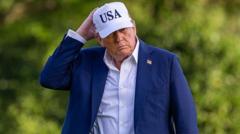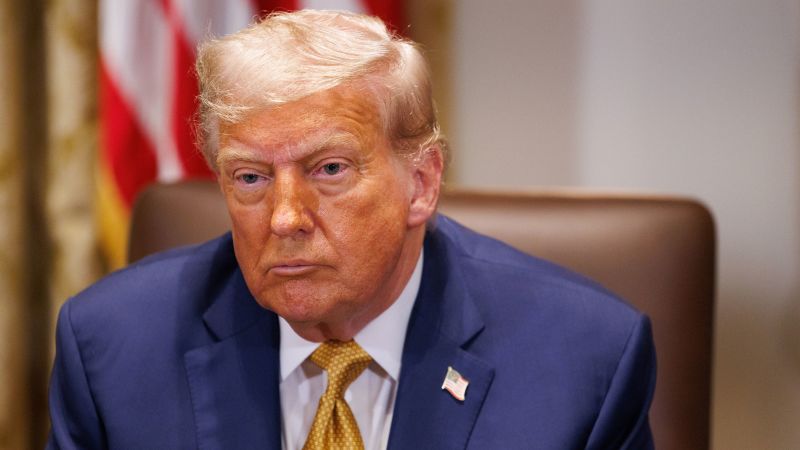Will Trump's Tariff Delay Change the Global Trade Game?

Understanding the Impact of Trump's Trade Policies on Global Economics
In the complex web of international trade, few figures have sparked as much debate and speculation as Donald Trump. His administration made bold promises, notably the "90 deals in 90 days" initiative aimed at reshaping America's trade relationships. However, the reality has proven starkly different, with delays and unfulfilled commitments raising questions about the effectiveness of these policies. This article delves deep into the implications of Trump's trade policies, exploring their effects on the global economic landscape, the U.S. economy, and the relationships with key trading partners.
The Premise of "90 Deals in 90 Days"
When Trump took office, his administration aimed to renegotiate trade agreements to reduce the U.S. trade deficit, famously promising "90 deals in 90 days." This ambitious goal was meant to address what Trump described as unfair trade practices that were detrimental to American workers. However, less than a month from the initial deadline, it became evident that the administration was struggling to meet even a fraction of this target. By the extended cut-off date of August 1, it was clear that fewer than ten deals had been formalized, highlighting a significant gap between expectation and reality.
The Extension of Deadlines
The extension of deadlines from July to August—and the potential for further delays—signals more than just a logistical setback. It's a reflection of the Trump administration's challenges in navigating the complex world of international trade negotiations. This situation raises an important question: Is the U.S. losing its bargaining power on the global stage?
The U.S. Trade Deficit: A Central Focus
Treasury Secretary Scott Bessent pointed out that the administration's focus is on 18 countries responsible for 95% of America's trade deficit. This concentrated effort signifies an intent to directly tackle the root causes of the trade imbalance. However, the effectiveness of this approach is under scrutiny as the results remain underwhelming.
The "Liberation Day" Letters
The letters sent to trading partners, reminiscent of the "Liberation Day" blue board, essentially reiterated previously announced tariff rates. This lack of new information suggests a stagnation in the negotiation process and a failure to produce the desired outcomes. The reliance on historical data, like using trade deficits as a proxy for trade violations, complicates the ability to forge meaningful agreements that could benefit U.S. interests.
The Market's Reaction: Calm Before the Storm?
Despite the delays and ongoing trade tensions, financial markets have responded with surprising calmness. The perception that the Trump administration may backtrack on its more aggressive trade policies has bred skepticism among investors. This skepticism, encapsulated in the notion of TACO (Trump Always Chickens Out), suggests that markets are bracing for a prolonged period of uncertainty.
The Potential for a Renewed Crisis
While the current market environment appears stable, the ongoing delays could embolden nations to stall negotiations, potentially leading to a renewed crisis. As the adage goes, "the market hates uncertainty." The longer the U.S. takes to finalize trade agreements, the more likely it is that economic repercussions will ensue.
International Reactions: Japan and South Korea
The initial letters targeted Japan and South Korea, two of America's key trading partners. Both nations have expressed their frustration with the U.S. approach, with Japan's finance minister hinting at leveraging its substantial holdings of U.S. government debt as a bargaining chip. This development raises concerns about the potential for retaliatory measures that could further escalate trade tensions.
Global Trade Dynamics: A Shift in Focus
As the U.S. erects tariff barriers, global trade dynamics are shifting. Countries are increasingly looking to trade with one another rather than relying on the U.S. market. For instance, China's exports to the U.S. have declined by 9.7% this year, while its exports to other regions have surged. This trend indicates a potential reorientation of global trade patterns, with countries seeking new markets to mitigate the impact of U.S. tariffs.
The Value of the Dollar: A Double-Edged Sword
One of the anticipated benefits of Trump's trade policies was an increase in the value of the dollar, which was expected to counterbalance inflationary pressures from tariffs. Contrary to expectations, the dollar has depreciated by roughly 10% against several currencies this year. This decline complicates the economic landscape further, as imported goods become more expensive, driving inflation and impacting consumers.
Impact on Tariff Revenues
Despite the challenges, the U.S. Treasury has seen record tariff revenues, particularly in May. However, these revenues come with caveats. As the U.S. imposes higher tariffs, the effective tariff rate has risen to about 15%, a significant increase from the historical averages of 2% to 4% over the past four decades. This shift not only impacts consumers but also poses risks to the overall economic stability.
Global Economic Relationships: The Rise of New Alliances
In response to U.S. trade policies, countries are forming new economic alliances. Recent trade agreements between the UK and India, as well as between the EU and Canada, illustrate a strategic pivot away from reliance on the U.S. market. These developments may signify a long-term shift in global economic relationships, potentially reducing the U.S.'s influence in international trade.
The Future of Trade Agreements
The ongoing delays in finalizing trade agreements and the potential for further complications raise critical questions about the future of U.S. trade policies. As other nations adapt to the new trade landscape, the U.S. must reassess its strategies to remain competitive on the global stage. The ability to forge meaningful and mutually beneficial agreements will be crucial for the U.S. economy moving forward.
Conclusion: A New Era of Trade
As the world watches the unfolding events surrounding U.S. trade policies, it is clear that we are entering a new era of international trade characterized by uncertainty and shifting alliances. The Trump administration's ambitious goals have encountered significant hurdles, leading to delays and an evolving global trade landscape. The implications of these developments extend beyond immediate economic concerns, influencing relationships among nations and the future of global commerce.
In a world where trade agreements are no longer merely transactional but politically charged, the U.S. must navigate carefully to maintain its economic standing. As we ponder the future of trade, one question looms large: How will the U.S. adapt to this new reality, and what role will it play in shaping the future of global trade?
Frequently Asked Questions
What are the key challenges facing U.S. trade negotiations?
The U.S. faces several challenges, including the need to renegotiate existing agreements, address trade deficits, manage international relationships, and navigate domestic opposition to tariffs.
How have tariffs impacted American consumers?
Tariffs have generally led to increased prices for imported goods, which can drive inflation and reduce purchasing power for consumers in the U.S.
What is the significance of a declining dollar?
A declining dollar can make imports more expensive, leading to inflation, while also potentially making U.S. exports cheaper and more competitive in global markets.
In today's rapidly changing economic landscape, how do you foresee the future of U.S. trade policies shaping the global economy? #TradePolicies #GlobalEconomy #TrumpAdministration
Published: 2025-07-08 23:04:03 | Category: technology



